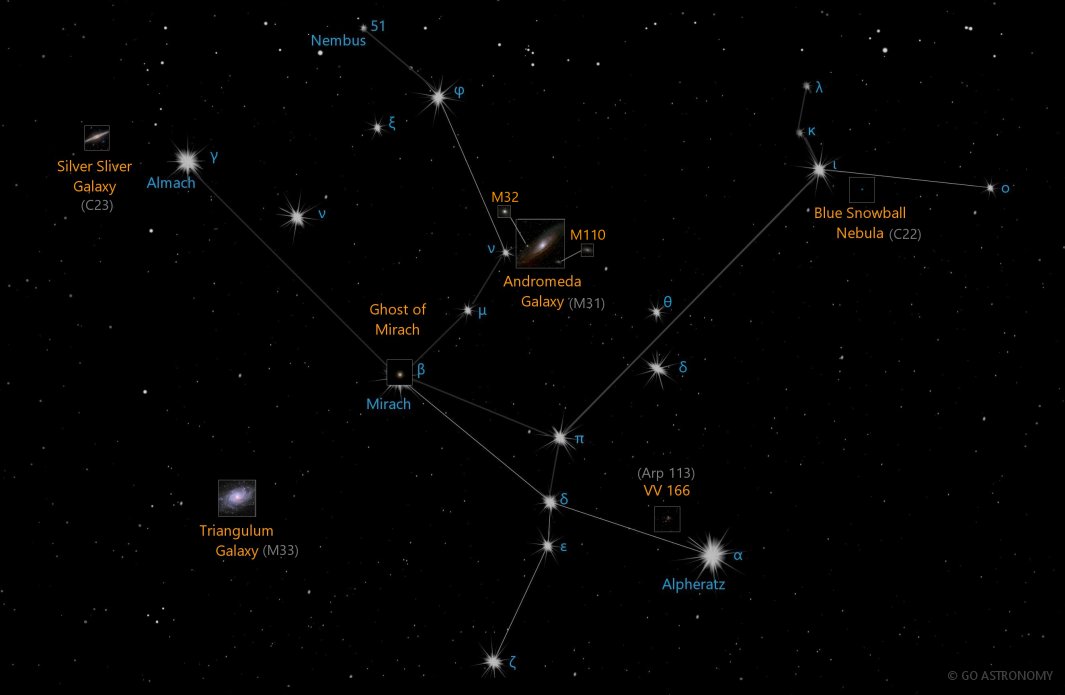Andromeda, the Daughter of Cepheus (And)
(an-DRAH-mih-duh)
The Northern constellation of Andromeda, the Daughter of Cepheus, is best viewed in Fall during the month of November.
Andromeda is the 19th largest constellation. It's brightest star is Alpheratz at magnitude 2.10. The boundary of the Andromeda constellation contains 19 stars that host known exoplanets.
Ross-248 (Gliese 905) is the 10th closest star to Earth at 10.3 light years.
- Pronunciation:
- an-DRAH-mih-duh
- Meaning:
- Daughter of Cepheus
- Genitive:
- Andromedae
- Abbreviation:
- And
- Constellation Family:
- Perseus
- Hemisphere:
- Northern
- Quadrant:
- NQ1
- Visibility:
- 90° N - 40° S
- Best viewing month*:
- November
- Area:
- 722 sq. degrees
- Size:
- 19th largest
- Right Ascension (avg):
- 0h 34m
- Declination (avg):
- 41°
- Brightest star:
- Alpheratz (2.10)
- Stars with planets:
- 19
Brightest Stars in Andromeda
The 10 brightest stars in the constellation Andromeda by magnitude.
- Star
- Magnitude
- Spectral class
- Alpha Andromedae (α And)
- 2.07
- B9p
- Beta Andromedae (β And)
- 2.07
- M0IIIvar
- Gamma Andromedae (γ1 And)
- 2.1
- K3IIb
- Delta Andromedae (δ And)
- 3.27
- K3III
- 51 Andromedae (51 And)
- 3.59
- K3III
- Omicron Andromedae (ο And)
- 3.62
- B6pv SB
- Lambda Andromedae (λ And)
- 3.81
- G8III-IV
- Mu Andromedae (μ And)
- 3.86
- A5V
- Zeta Andromedae (ζ And)
- 4.08
- K1II
Double Stars in Andromeda
These are the brightest and easiest-to-find double, triple, and quadruple star systems in the constellation Andromeda. Also see all star clusters.
- Star system
- Magnitudes
- Type
- Gamma Andromedae
- 2.3, 5.0
- double
Star Clusters in Andromeda
The most notable and easy-to-find star clusters in the constellation Andromeda . Also see all star clusters.
Nebulae in Andromeda
Notable and easy-to-find nebulae in the constellation Andromeda . Also see all nebulae.
Galaxies in Andromeda
The most notable galaxies in the constellation Andromeda. Also see all galaxies.
- Name
- Alt name
- Type
- Andromeda Galaxy
- M31
- spiral
- Edward Young Star
- M110
- elliptical
- Le Gentil
- M32
- elliptical
- Arp 113
- galaxy group
- Arp 273
- galaxy pair
- Mirach's Ghost
- lenticular
- NGC 90/93
- galaxy pair
- Silver Sliver Galaxy
- C23
- spiral
Black Holes in Andromeda
These are the most well-known smaller (non-supermassive) black holes in the constellation Andromeda. Although black holes cannot be seen directly, the smaller ones are at the center of some star clusters and supernova remnant nebulae, which can be seen. Supermassive black holes are at the center of most galaxies, such as Sagittarius A* at the center of our Milky Way galaxy. Also see all black holes.
- Black hole
- Type
- Messier 110
- intermediate
The Chained Maiden
One of the oldest and largest constellations known to astronomers, Andromeda is filled with a multitude of deep sky objects and celestial wonders. Named after the mythical Greek princess Andromeda, it is part of the Perseus family of constellations and is steeped in both astronomical and mythological significance.
Location and Mythology
Located in the northern hemisphere, Andromeda is bordered by several constellations, including Perseus, Cassiopeia, Pegasus, and Pisces. It is most easily found by locating its brighter stars, particularly Alpheratz, which is also part of the famous Square of Pegasus asterism.
The constellation's mythological origin comes from the tale of Princess Andromeda. According to the story, Andromeda was chained to a rock as a sacrifice to a sea monster, but was saved by the hero Perseus who later married her. This myth is represented in the night sky, as the constellations of Andromeda, Perseus, Cassiopeia, and Cetus (the sea monster) are all found in close proximity.
Notable Stars
Andromeda hosts several notable stars. Alpheratz, the constellation's brightest star, is a binary system comprising two hot blue stars. Mirach and Almach are two other significant stars, with Almach being a beautiful double star with golden and blue-green components.
Andromeda Galaxy
Perhaps the most famous feature of Andromeda is the Andromeda Galaxy (M31), the closest spiral galaxy to the Milky Way and one of the few galaxies visible to the naked eye from Earth. M31 is on a collision course with the Milky Way, but fear not - this cosmic event is not expected to occur for another four billion years. Apart from M31, Andromeda hosts several other galaxies including M32 and M110.
Deep Sky Objects
Along with the Andromeda Galaxy and its companions, the constellation boasts a rich assortment of deep-sky objects. These include NGC 752, an open cluster easily visible with binoculars or a small telescope, and the Blue Snowball Nebula (NGC 7662), a planetary nebula that appears as a blue disk under higher magnifications.
Observing Andromeda
For the amateur astronomer, Andromeda offers a variety of interesting objects to view. The Andromeda Galaxy is a popular target, particularly in the fall, and can be observed with the naked eye in dark sky conditions, or with a telescope in more light-polluted areas. Its other deep-sky objects provide an enticing challenge for observers with a modest telescope.
* Constellation shown for northen hemisphere skies. For the southern hemisphere, constellations appear rotated 180 degrees (upside-down and left-right reversed) from what is shown. Remember that seasons are reversed too - summer in northern latitudes is winter in southern latitudes.
** Circumpolar constellations are visible year-round in the hemisphere listed (and not at all in the opposite hemisphere).





